Intel Core 2 Quad Q9550S: A New 65W Quad-Core
by Anand Lal Shimpi on January 27, 2009 8:00 PM EST- Posted in
- CPUs
Adobe Photoshop CS4 Performance
To measure performance under Photoshop CS4 we turn to the Retouch Artists’ Speed Test. The test does basic photo editing; there are a couple of color space conversions, many layer creations, color curve adjustment, image and canvas size adjustment, unsharp mask, and finally a gaussian blur performed on the entire image.
The whole process is timed and thanks to the use of Intel's X25-M SSD as our test bed hard drive, performance is far more predictable than back when we used to test on mechanical disks.
Time is reported in seconds and the lower numbers mean better performance. The test is multithreaded and can hit all four cores in a quad-core machine.
Before we get to performance let's look at idle power consumption:
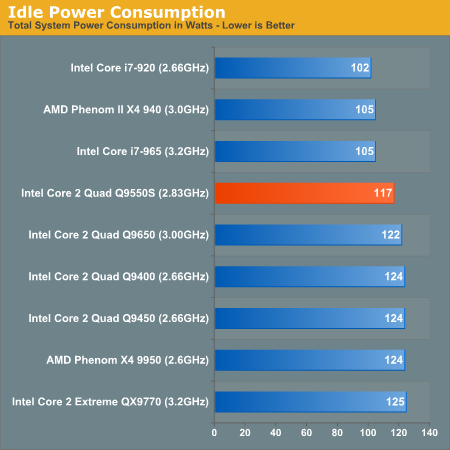
Now let’s look at performance:
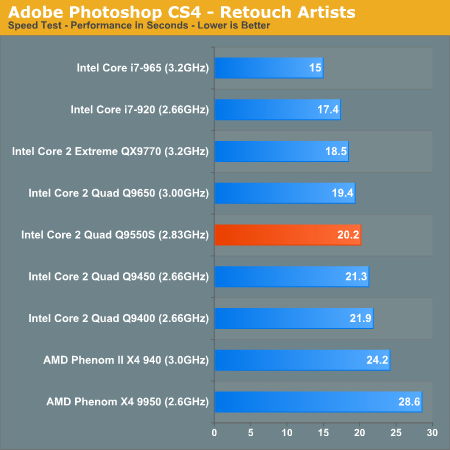
The best performers in this benchmark, by far, are the Core i7 processors. If you’re building the ultimate Photoshop machine, Core i7 is what you want. The entry level Core i7-920 is faster than the Core 2 Extreme QX9770, despite the latter being priced at over $1000.
Note that the Core 2 Quad Q9550S performs identically to a Core 2 Quad Q9500; right in between a Q9650 and a Q9450, just as you’d expect.
Next we measured the average power consumption of the entire machine during the Photoshop benchmark, the results are reported in watts. Lower numbers are better here:
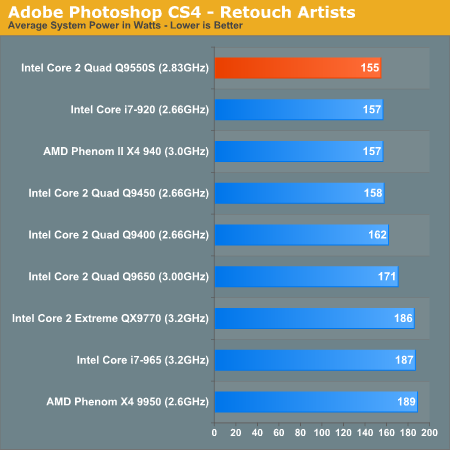
Now we see the benefit of the new -S parts; the Core 2 Quad Q9550S draws less power than any other chip we tested, including the much smaller, cooler running Q9400. While the Q9550S still uses the original 820M transistor Penryn core, the Q9400 is a smaller 456M transistor part.
While we don’t have a real Q9550 to compare to, if you look at the power consumption of the Q9650 and the Q9450 you can estimate that a Q9550 would be somewhere in between - perhaps around 165W. That would put the average energy savings of the 9550S at 10W.
We can also look at the maximum power consumed during the course of the test:
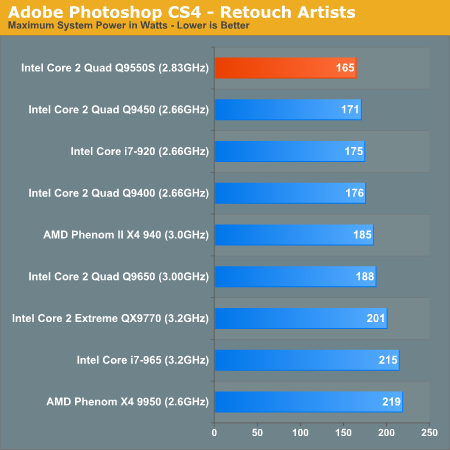
The Q9550S’ advantage amounts to around 15W under peak power draw.
Efficiency is equally important, here we’re looking at total energy consumed by the system over the life of the test. Energy consumed takes into account how long the test takes to complete, which will be shorter on faster machines.
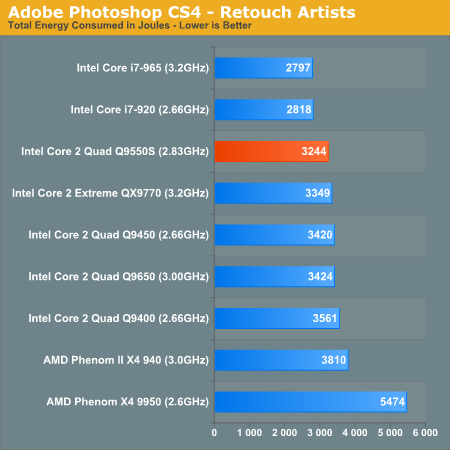
Here the Q9550S is marginally better than its Penryn siblings. There’s about a 5% drop in total energy consumed compared to a Q9650. And this is where the argument for energy efficiency falls short with the Q9550S; look at the total energy consumed on the Core i7, it blows the Q9550S out of the water.
While the Core i7-920 draws as much as 6% more power than the Q9550S, it also completes the benchmark in nearly 14% less time. If you want the best performance per watt, skip the Core 2 Quad Q9550S and buy the Core i7-920.










62 Comments
View All Comments
UltraWide - Wednesday, January 28, 2009 - link
why was a normal 95W TDP Q9550 not included???Anand Lal Shimpi - Wednesday, January 28, 2009 - link
I didn't actually have a 95W Q9550 available (Gary has the one we used in our Phenom II review). I provided the Q9650 and the Q9450 so you can get an idea of where the Q9550 would fall.Take care,
Anand
StraightPipe - Thursday, January 29, 2009 - link
I've got to agree with UltraWide.The news is Intel just came up with the S-line of procs.
But the test doesnt compare any S to non-S CPUs...
Isnt that what really matters? the perfomance and power consumption difference between the 95W and the new 65W is what I want to see.
anandtech02148 - Wednesday, January 28, 2009 - link
finally nice to see the pick and choose Anandtech bench, need to take it out of beta, save me a trip to tomshardware.Calin - Wednesday, January 28, 2009 - link
Those processors are perfect as replacements in servers already validated for the 95W version of the same processor. While buying i7 would be better, maybe the i7 servers weren't validated (remember the 3 years of support for business-related hardware lines)danchen - Wednesday, January 28, 2009 - link
looking at the numbers, it doesn't look like its worth the extra money.Its like buying an "environmentally friendly" car - high initial investment, takes many years to get an ROI.
perhaps if you're the type who runs your computers 24/7, it may actually save you some bills in the long run.
rpsgc - Wednesday, January 28, 2009 - link
Or... you could just undervolt your current CPU. Voilà.BTW, what is the default Vcore of these processors?
WillR - Wednesday, January 28, 2009 - link
Depends on the model, but I assume you mean the likes of the Q9550. Those are 1.22V.http://www.anandtech.com/cpuchipsets/showdoc.aspx?...">http://www.anandtech.com/cpuchipsets/showdoc.aspx?... shows a few.
lucassp - Wednesday, January 28, 2009 - link
"the publicly available x264 codec (open source alternative to H.264)"firstly x264 is only an encoder, and doesn't have an encoder included. x264 is an Open Source implementation of the H.264 standard. it's not an alternative to it.
lucassp - Wednesday, January 28, 2009 - link
sorry for the mistake, I meant to say it doesn't have a decoder included ;)